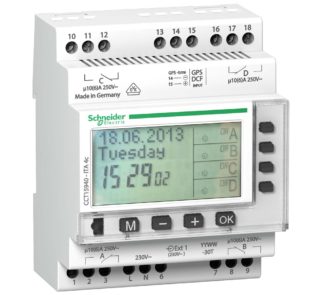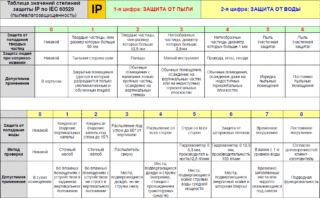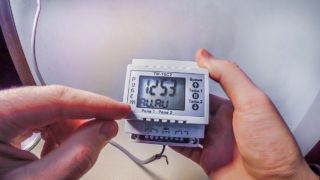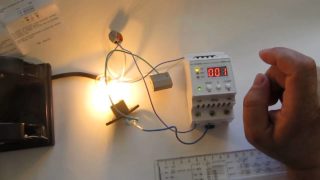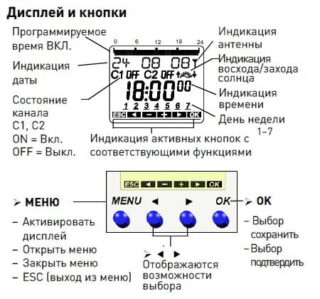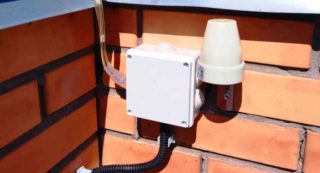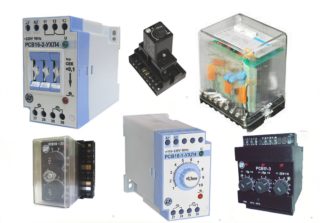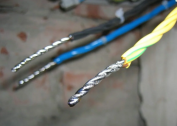For the rational operation of electrical devices using automated control systems. The programmable time relay is capable of performing a lot of useful functions, including turning devices on and off according to a given algorithm.
What is a time relay
In French, the word "relay" is translated as "replace", but in practice, the term refers to an electric or electronic key, which is necessary for switching sections of electrical circuits and control the consumption of electricity. This concept is characteristic of conventional electromagnetic devices. The programmable device, or timer, sends a command to connect or disconnect electrical circuits automatically, according to the settings set by the user.
The electromechanical device closes or opens the contacts when a small electric current is supplied to the coil of the relay coil. The emerging magnetic field drives the “armature” with which the switching contacts are connected. Thanks to this process, the network opens and closes. Recently, solid-state relays are widely used. They have powerful semiconductor switches and can withstand heavy loads.
If the circuit needs to be switched not at the time of signal supply, but at a certain moment, a more complex device is used - a time relay (PB). They work after a certain period, providing a sequence of actions. Thanks to the principle of operation, it is possible to build electrical circuits of different complexity. With the help of such schemes, control functions of various equipment are carried out.
For example, a relay is indispensable for organizing automatic watering, turning off lights in a common corridor, turning a compressor on and off in an aquarium.
Operating principle
The main function of the RV is the formation of the time delay of switching control groups of contacts. The implementation of the delay depends on the design of the device. There are many varieties of PB. From a functional point of view, they are pneumatic, motor, electromagnetic, electronic, as well as devices on the clockwork. They differ in parameters, appearance and installation method, have the following technical characteristics:
- maximum switched current;
- rated voltage of switching;
- type of contacts, their number;
- wear resistance (estimated number of inclusions);
- degree of protection IP.
The electronic timers indicate the rated supply voltage and power consumption. As well as the period of storage of the programmed data in the event of a power outage. The presence of an informative screen and control system makes it possible to support several tasks simultaneously.
Devices are divided into devices with a delay off or on. Many relays have two options at once, changing the type of switching. The operation algorithm is as follows:
- During startup, the contact group is activated - the contacts are closed for the relay with a delayed shutdown.
- The time delay mechanism is cocked.
- After the programmed interval has elapsed, the contact group changes order.
The on delay relay works in a similar way. In devices of a cyclic type, a given sequence is repeated many times.
What elements does a time relay include
 A monoblock device is an independent device in a separate case with built-in power, inputs and outputs, a display and a control panel. The off delay relay has a coil and two types of contacts - normally open and normally closed. On the front panel near the screen there are keys for setting.
A monoblock device is an independent device in a separate case with built-in power, inputs and outputs, a display and a control panel. The off delay relay has a coil and two types of contacts - normally open and normally closed. On the front panel near the screen there are keys for setting.
The relay may have autonomous power, included in the network and input for an electrical device. In this case, the relay is a self-controlled outlet.
Built-in devices are part of an electrical appliance, do not have their own enclosure. An example is the programmable mode of operation of a microwave oven, electric oven, or washing machine.
The program is set manually. The desired period of time is set, after which the relay commutes the electrical circuit. If necessary, you can program a specific day of the week, weekend or work shift. The device has parameters that explain its programmable functionality:
- possible range of time delay (in seconds, minutes, hours, days);
- number of connections;
- features of settings;
- time error per day, in seconds.
Electronic PB have a magnetic circuit, a control winding and a short-circuited coil. They are equipped with computer input / output ports, which greatly expands the functions of the device. Different types differ in the number of inputs and outputs, switching ability, type of current, voltage, and the number of tuning steps. Some of them allow you to monitor online connected relays and display relevant information.
The scheme of the device
A time relay with a turn-off delay of 220V RZV-1 is used in automation circuits, for example, on a landing, for a fan in a bathroom. The response time range is from 1 second to 60 minutes. To set the time, you need to press and release the "PROG" button. Contacts open, and the time until the next press is stored in the device’s memory.
To change the delay period, the operation is repeated. The minimum delay is 1 second, if there is no repeated pressing, the relay will operate after 60 minutes. The device memory will record the maximum delay time - 1 hour. When the contact is closed, the relay is turned on, when opened, the timer. PB disconnects the load after a specified time.
The contact can be represented as a button without fixing, as well as a conventional switch. When switching, a light or any other load turns on and the programmed time begins. At the end of the set period, the device turns off.
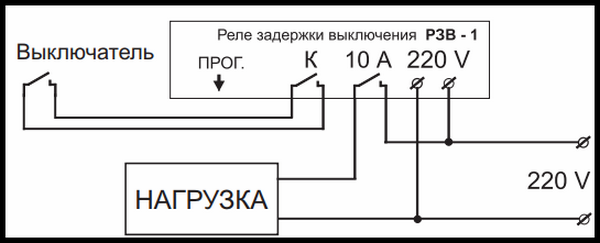
An adjustable device with a digital scale - a socket with a timer, is widely used at home, makes it possible to control any household appliances. The duration of the action is set in the daily range, which is quite enough for daily use. The instruction explains how to set the drive pointer to the current time. The design of such a mechanical relay allows you to organize up to 48 starts during the day.
Relay testing
Electronic devices operate on the basis of digital pulses. Modern devices have high-performance microprocessors. Typically, the RV is designed for switching inductive or non-inductive loads. To configure the digital type instrument, you will need to enter the necessary time parameters using the function keys. The possibility of wide customization allows you to set not only seconds but also days of the week.
The purpose of testing is to understand the design and principle of operation of the time relay. Checking the device when it is turned on again is performed in the following sequence.
- External inspection and verification of the mechanical part.
- Checking the action of the spark arrestor circuit.
- Testing the rectifier device.
- Determination of current resistance of a winding circuit.
- Checking voltage during operation and return.
- Control of response time.
Testing of the main parameters is carried out using a special device. When inspecting the mechanical part, corrosion, pollution are revealed. Check the progress and balancing of the moving parts, the state of the axles and springs, the tightening of the screws and axial play.
An important point is to check the insulation strength. Voltage alternately affect all the plinths and clamps. The insulation must withstand a voltage of 1000 V at an AC frequency of 50 hertz.
The probable error lies in the soldering, the conclusions of the coils and resistances. And also in the place of passage of the conductor through the hole of the board, plastic washers that fix the contacts on the axis.
Other functions
Modern control systems have a variety of capabilities. In some models, the additional functions of the programmable relays are displayed in three main and two mixed modes, which are indicated as follows:
- H - weekly timer;
- U - voltage relay;
- F - photo relay;
- HU - weekly timer with controlled voltage;
- FU - photorelay with voltage control.
A weekly timer automatically performs an important daily function. For example, optimization of the parameters of a greenhouse or hatchery. Can control the work of fountain devices, advertising structures.
Relay U protects electrical equipment from possible fluctuations in mains voltage. The connected device displays its actual value on the display.
If the value is within the specified limits, the load is turned on. When the voltage goes beyond the upper or lower threshold, the load is not connected.
A photorelay is the best option for programmable operation of lighting fixtures. It can be used both in everyday life and for controlling the illumination of various structures, lighting of garden and park areas, streets, and other public places.
There are also devices that combine the functions of a timer, photorelay and voltage relay. The non-volatile memory of such a device allows you to save the programmed parameters not only during voltage drops, but even during power outages. Usually, the permissible value of the load current for the device relay is up to 16 amperes. If the operating current is greater, the equipment is equipped with a magnetic starter or contactor.
The listed devices are intended for switching the load, according to the set time, voltage control and disconnecting consumers with significant fluctuations in the electrical network. Moreover, after the restoration of the parameters, they are automatically turned on. Switching the set level of illumination, other programmable actions.
Time Relay Benefits
Analog and digital time relays are very convenient for controlling the executive circuits of various household and industrial devices.
The on and off relay has a number of positive factors:
- optimizes the operation of household electrical and pumping devices;
- energy saving when connecting the "smart home" system;
- switching production equipment, mechanisms and other devices;
- settings allow you to choose a mode convenient for a single user;
- installation of cyclic shutdown and inclusion is possible;
- an alarm sounds when the device is triggered.
In everyday life, the timer is used to operate the fan, refrigerator, air conditioner, and lighting optimization. The device can be used in educational organizations, workshops and schools, for example, to make a call. Farms establish special artificial light for the growth and development of animals. In production, using relays, various machines and mechanisms are switched on and off.In agriculture, the relay controls irrigation and irrigation systems, pumping stations and ventilation units.
What to look for when buying
To select a suitable model should be guided by the basic parameters of the device. Various models can be connected to a household network of 220 V, as well as to lowered management networks of 12, 42 and 127 V.
The contact capacity of the contacts without overheating depends on the permissible load current. Where conditions do not allow switching contacts due to explosion hazard, contactless devices must be installed.
Indicators of moisture protection and temperature conditions determine the acceptable parameters of the operating environment. For the correct operation of the relay, you should pay attention to the following nuances:
- preference should be given to instruments with a wide possibility of setting the time;
- the control panel should be simple, clear;
- the picture of the display is clear and bright;
- numbers and icons are clearly visible, easy to read.
A simple programming language, the ability to switch from outdated systems based on relay-contactor circuits to microprocessor devices allowed programmable relays to take their rightful place in the market of new automation devices.
